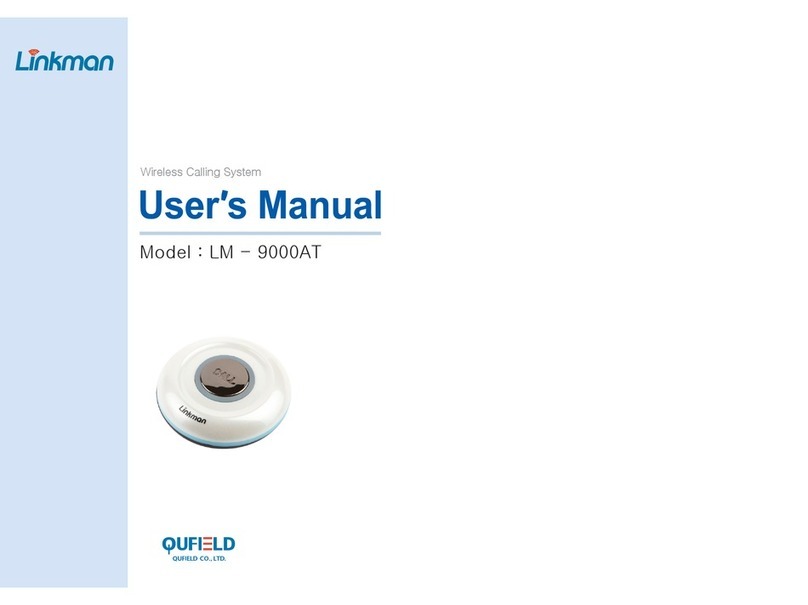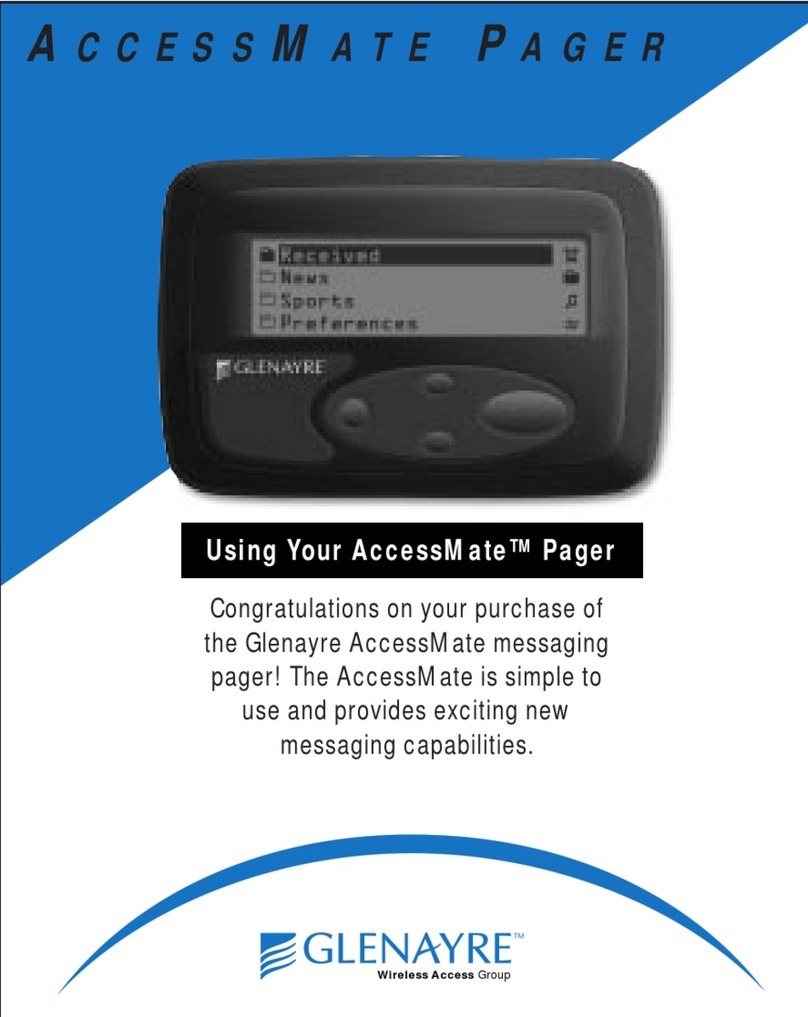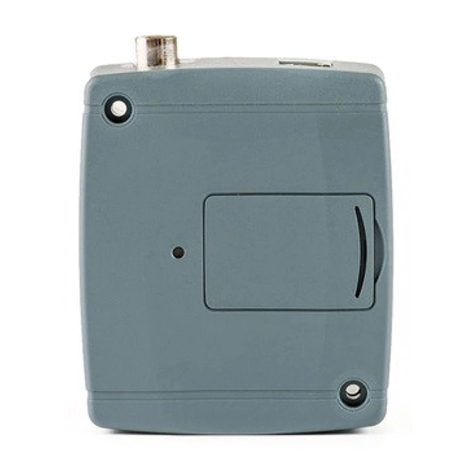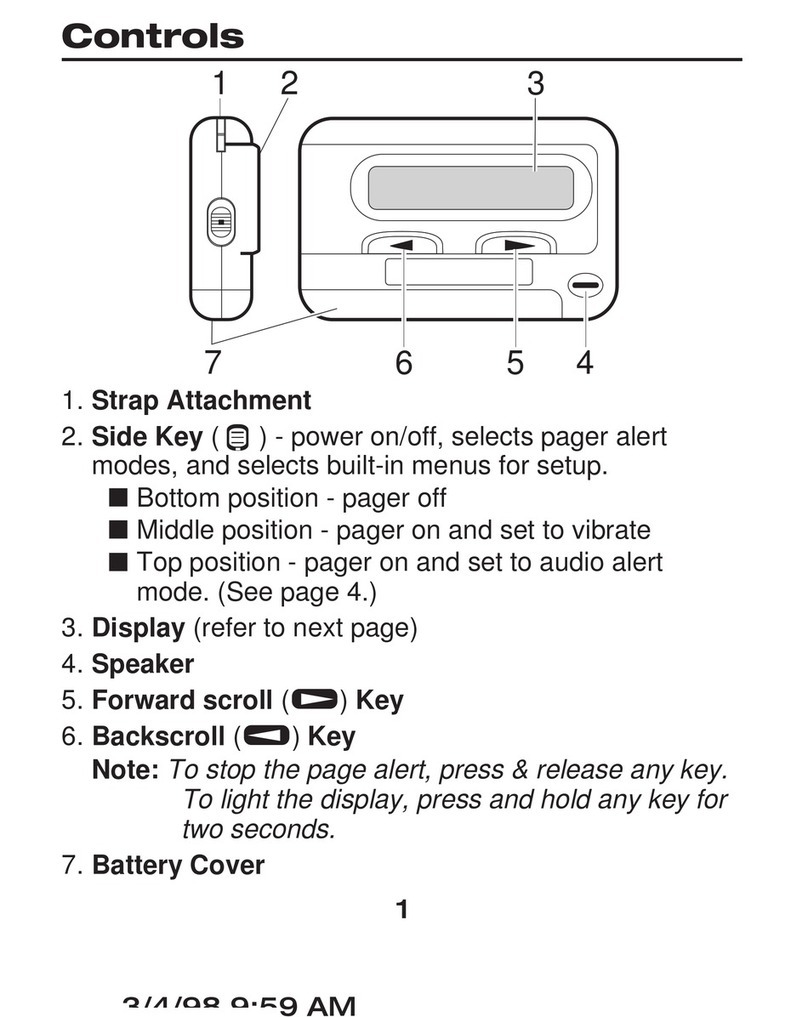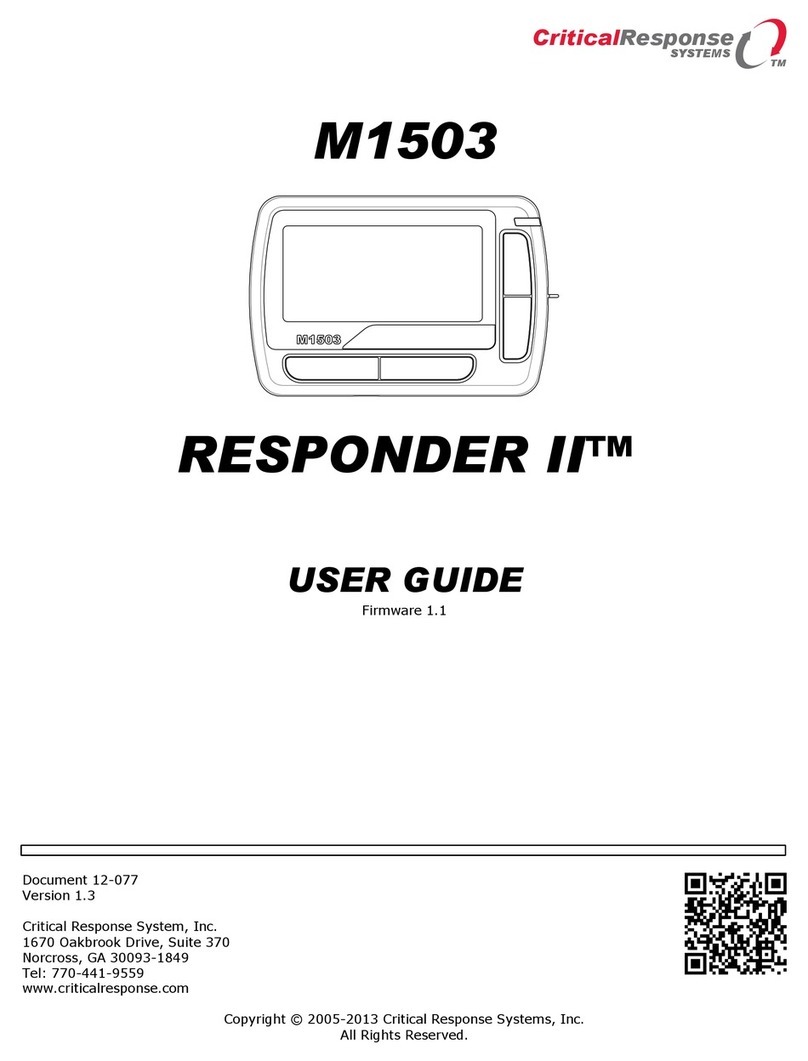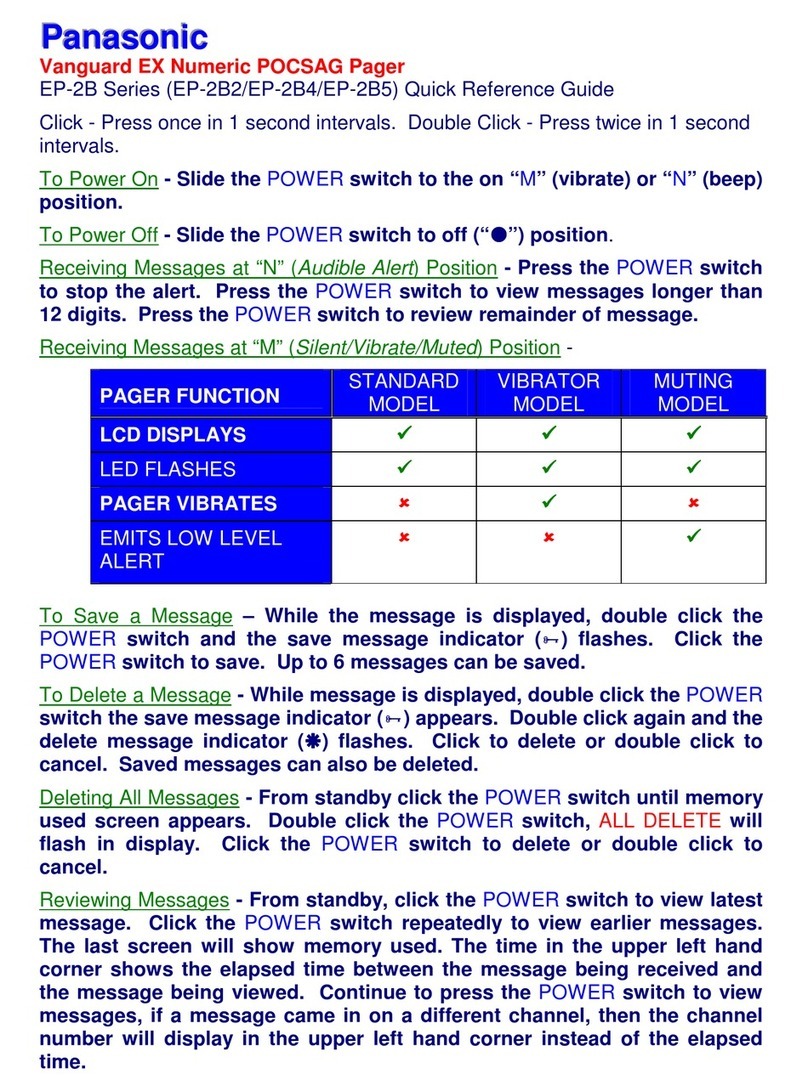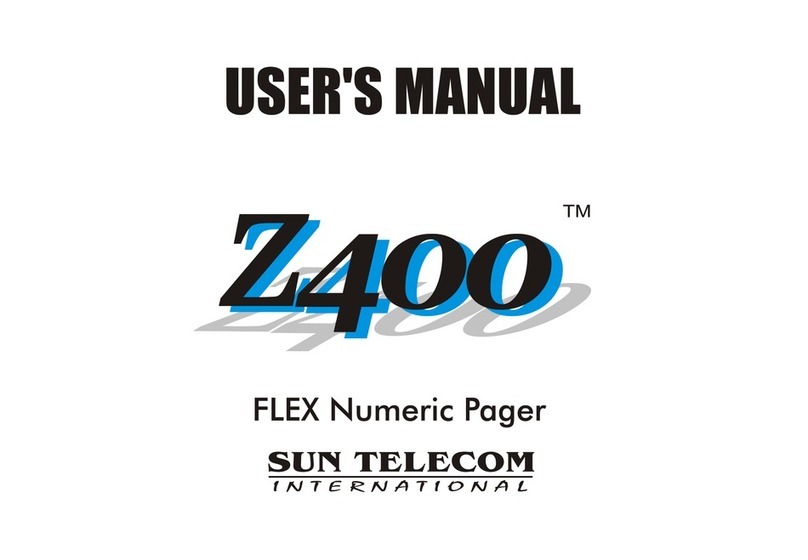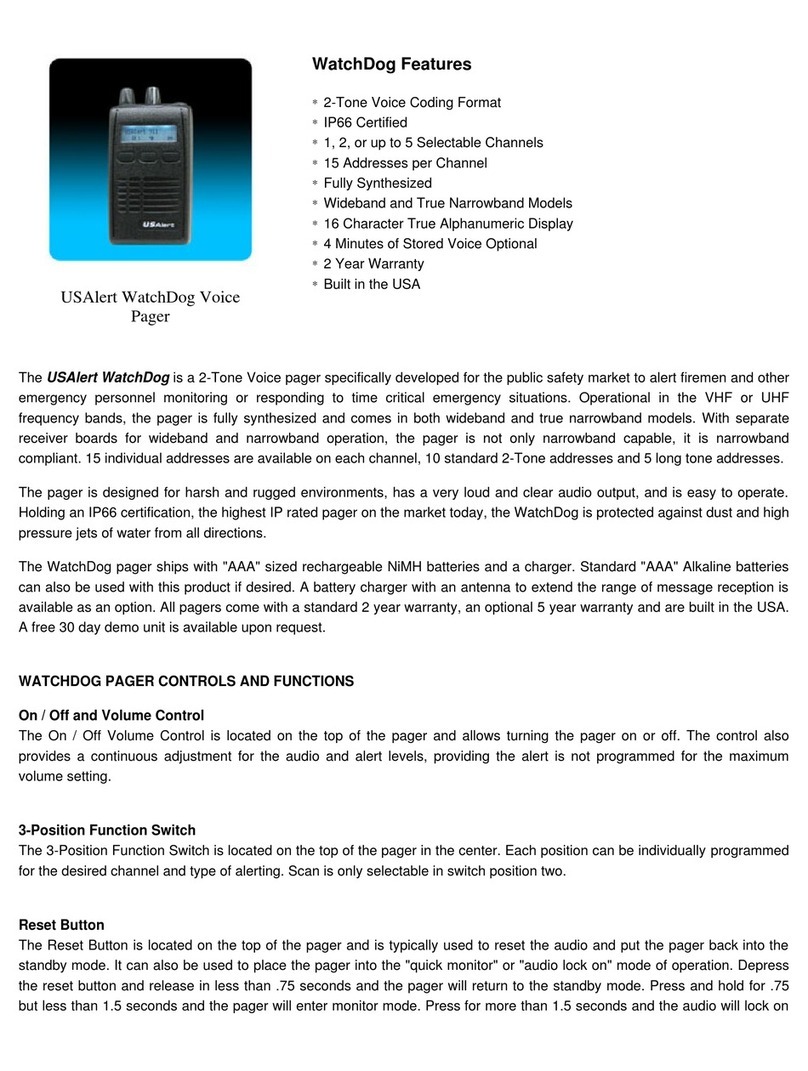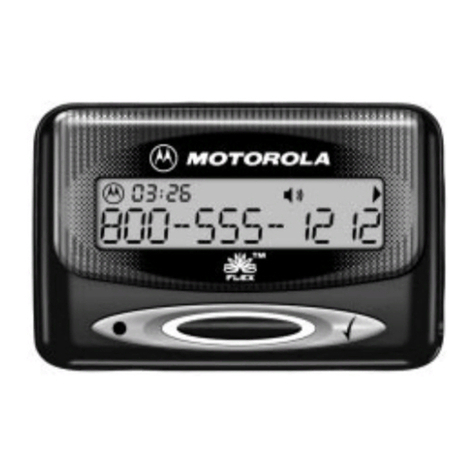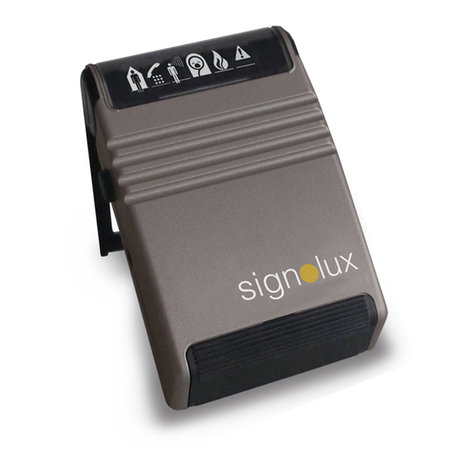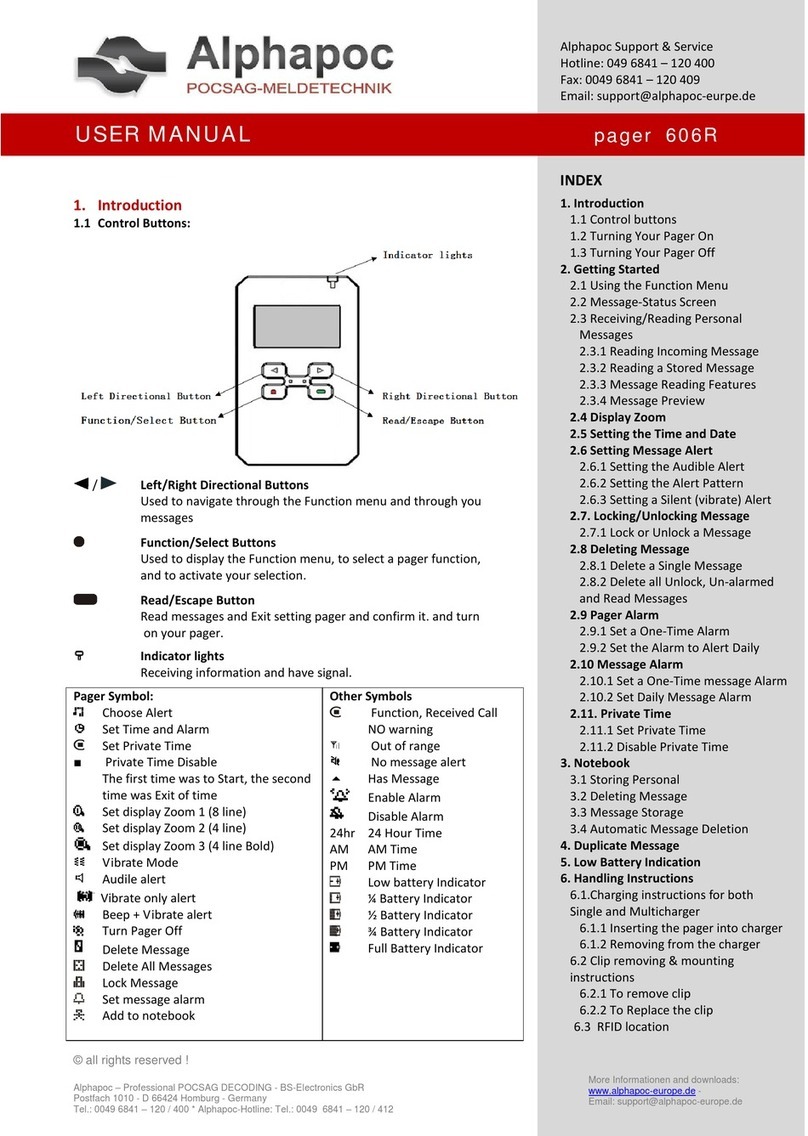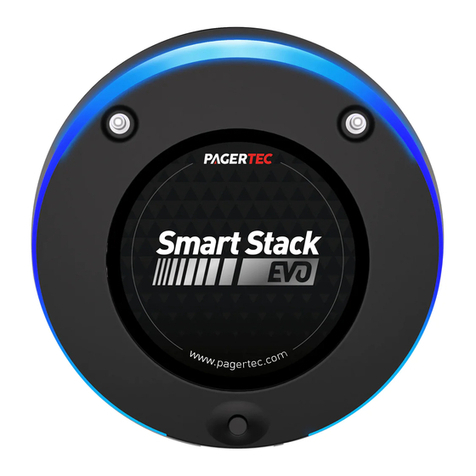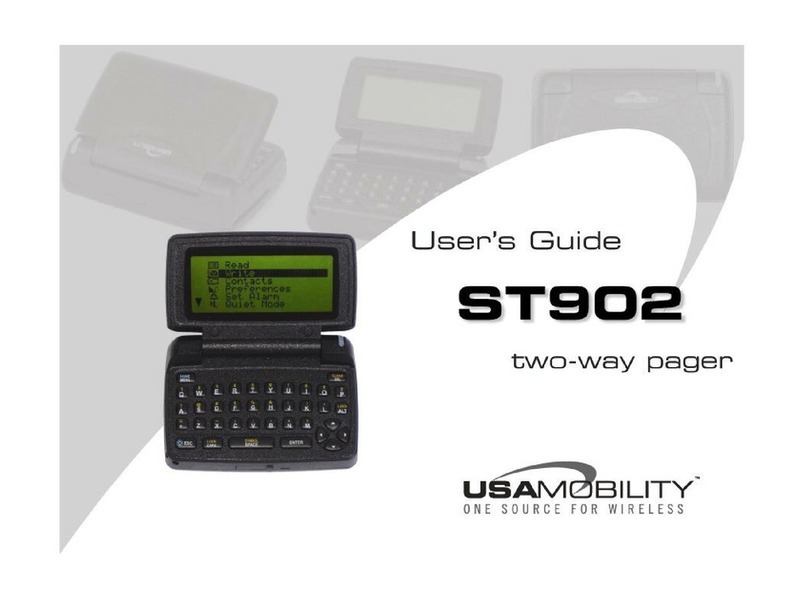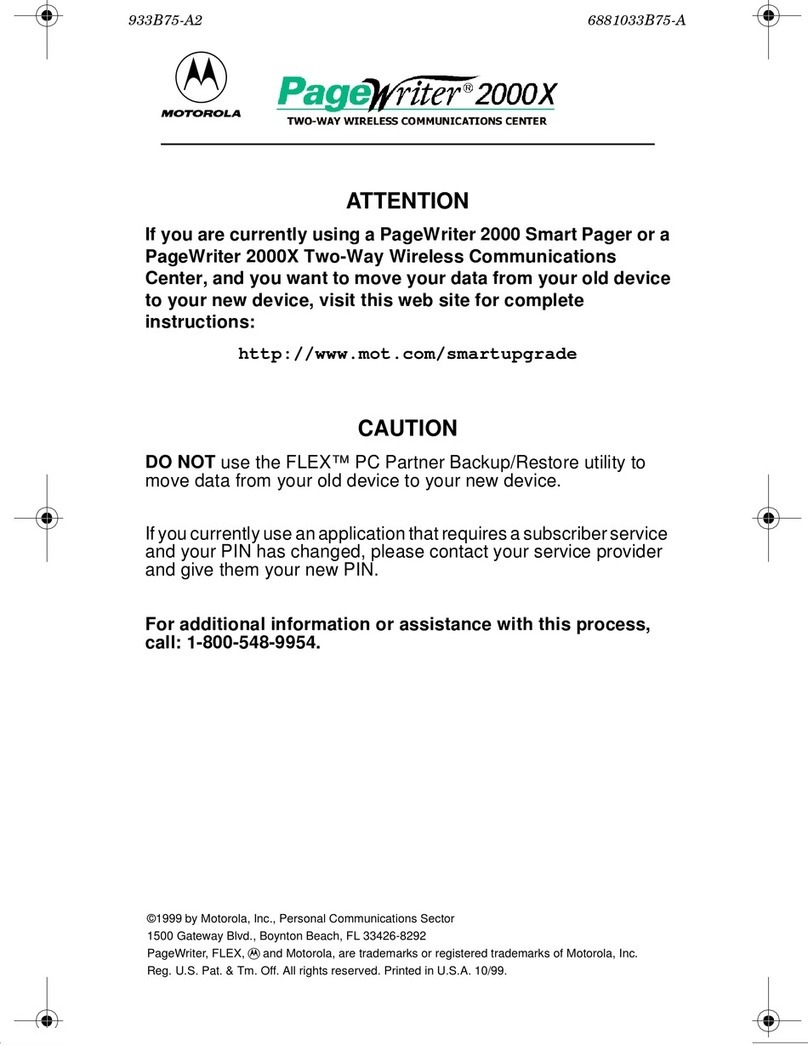Linkman PT-T100 User manual

1
INSTRUCTION MANUAL
Pager Transmitter : PT-T100 (V2.1)
Card Pager : PT-D100, PT-R100
Home Station & Charger : PT-C100, PT-C030
Repeater : PT-K100
Card Pager Kitchen -> Waiter
Counter -> Waiter
Reception, Office -> Staff
LEE Handels GmbH
Wersener Landstr. 78, 49076 Osnabrück / Germany
Tel: (+49) 541 470 5689 Fax: (+49) 541 470 5690

2
- INDEX –
1. Introduction
2. Recommendations for use and maintenance
3. Components: Transmitter, card pager, home
station
4. Installation
5. Card pager configuration / identification
6. Transmitter key reference
7. Card pager(PT-D100) display symbols
8. Card pager(PT-D100) usage
9. Making calls
10. Configuring notification method for card pagers
11. Configuring group numbers to evade channel
interferences (for transmitter)
12. Usage of card pager (PT-R100) without display
13. Configuring group (channel) numbers of the
utilities (charger, repeater)
14. Troubleshooting
1. Introduction
Thank you for having purchased wireless calling system: LINKMAN.
LINKMAN can be used whenever it is necessary to manage a call service.
Before installing and using wireless calling system LINKMAN, read the instruction manual
carefully, especially the section on usage and maintenance.
2. Recommendations for use and maintenance
- Keep this manual for future consultations.
- After removing the packing make sure the device and all its components are intact and have
not been damaged through transport. In case of doubt, do not use the device and contact
qualified personnel. The packing materials (plastic bags, boxes or cartons) must not be left
within the reach of children as they are a potential source of danger.
- Use / connect devices with power adapter supplied.
- The receiver (pager) is designed to perform correctly in an environment at a temperature
between +5°C and +40°C.
- Before connecting the device to its adapter, make sure the main voltage is 220 volts.
- The use of any electric appliance requires a safety guideline which must be followed.
Do not not touch the device with wet or damp hands;
Do not use the device barefoot;
Do not pull the power cord or the device to unplug it;
Do not plug too many devices into the same outlet, to prevent fire and/or
overheating;
Do not leave the device exposed to natural conditions (rain, sunlight, etc);
Do not allow children or disabled persons to use the device without supervision.
- Before cleaning or performing maintenance on the device, unplug it or switch off the power.
- In case of breakdown or malfunctioning of the device, switch it off and do not tamper with it.
For any repairs contact dealers or Linkman (Clima World Italia).
- Never immerse the device in water.
- In case of thunderstorms, unplug the power adapt to prevent damage, otherwise install a
power protection device which can be found in specialized stores.
- Do not use the receiver near electromagnetic sources to prevent possible interference.
- Pacemakers, hearing aids and medical devices may undergo interference.
- The manufacturer reserves the right to make changes to the product at any time.

3
3. Components:
Transmitter, Card Pager, Home Station 4. Installation
•Unlock pager by switching the pin on the bottom of
the pager to the right.
•Activate pager by pressing for 4 seconds until a
beep sound is heard.
•Insert all pagers in the Home Station.
•Connect the Home Station to the transmitter through
the USB cable and turn it on.
•Plug the transmitter to electric current and turn it on.
•Wait for the pagers to recharge (red LED aside every
Home Station slot to stop blinking.
5. Card pager configuration / identification
Pager ID registration procedures:
•Insert the pager(s) into the Home Station
(make sure it is connected to the transmitter)
•Press the Reg. button on the transmitter.
•Press the nr. of the first pager of the sequence.
• Press: _ ” button.
•Press the nr. of the last pager of the sequence,
so the display shows something like “ID: 1-10”.
•Press (Enter).
The “PT-T100” model is a transmitter
which can call a specific range of pagers.
The programming of pagers can be done
through transmitters.
Signal range reaches up to 100 meters
(330 ft).
The signal range varies depending on
building’s structure and wall thickness.
Additional amplifiers may be installed to
increase signal range(optional: see pg.14).
The Home Station is an interface between the
transmitter and the pager. It can be
connected to the transmitter through a USB
supplied. It can simultaneously recharge 10
pagers(PT-C100) and 3 pagers(PT-C030).
Next to each rechargeable slot are two LED’s;
one red (charging status indicator) and the
other green (pager programming indicator).
Programming pagers can be done through
the Home Station as well.
The wireless pagers are pocket-sized and
can be hung on neck, on a belt, or on the
wrist with apt accessories.
The pagers run on internal lithium
rechargeable batteries.
The pagers are recharged by positioning it
into its unique slot on the Home Station.
PT-T100
PT-C100
PT-D100
Tasto
On/off

4
6. Transmitter key reference 7. Card pager(PT-D100) display symbols
Note:
If the pager isn’t going to be used for a long period of time
(over 5 days ex: holiday, closure), the pager should be best
turned off to ensure a long and efficient battery life (see s
ection 8).
To find Waiting
List (see page
12)
BZ.
Registration
Pager ID Main Function
(Program) Button
Enter
Secondary
configuration Button
Message functions
Alphabet or Numeric
Switch key
Close message edit
(max 5 glyphs)
Backspace
Removes
the last letter
/number
Power
On/off Key press
Sound
On/off Direct Call, memories a
message
Sends call
Clears the display
: Signal receive notification
: Insufficient battery, blinking signifies low
battery
: Ring tone
: Vibration
: Message notification, blinking signifies there
are unread messages
: Message deletion

5
8. Card pager(PT-D100) usage
Left key :
•While the pager vibrates / rings, it is necessary to
press once to stop signaling. Doing so ensures the
call/message has been read, and wont be reminded
again.
•Pressing the button another time will display the
message sent from the transmitter.
•If the button isn’t pressed within 10 seconds, the pager
will stop notification and pass on to saving mode; after
one minute, the message will be reminded again (up to
a max of 4 times).
•If the call wasn’t answered, press one time to view the
missed call and one more time to confirm having read it.
IMPORTANT: IT IS POSSIBLE TO DISABLE MISSED
CALL REMINDER(see section 10.4)
Right Key :
•Needed to scroll through the calls (saves latest 8).
Message deletion:
View the message by pressing the for one second,
afterwards a symbol will appear.
Press for one second to confirm deletion.
Turning the pager on/off
1. On/off through pager keys (PT-D100) :
To turn the pager off; press and straight afterwards
press ; keep both buttons pressed together for 5
seconds until it makes a beep sound. In order to turn
the pager back on, press for 4 seconds until it
makes a beep sound.
2. On/off through Reset Pin
(PT-D100, PT-R100) :
Position the reset pin to the left
NOTE:If no key is pressed within 10 seconds, the display will turn
off (saving mode). The display can be lit back up by
pressing any of the two buttons on the card pager.
Recharge time for card pager is 6 hours.
Battery life lasts around 12 hours.
It’s recommended to not charge more than 10 pagers for
each AC/DC adapter (transmitter).
*When pager’s face is looking up
PT-D100
Reset Pin
-Right : On *
-Left : Off * PT-R100

6
9. Making calls
9.1 Making direct calls to the pagers on one click
•Press HOLD, “DIRECT” should appear. At this
point, any one-digit number(0-9) pressed calls
that specifically registered pager.
•ex) Press 2 –“DIRECT 2” shows up and the
pager registered under ID: 2 would be called and
should display the default “---”.
•ex) Now press 6 –“DIRECT 6” appears without
having to delete the previous 2. The same thing
should happen as before.
9.2 Making direct calls from several transmitters
When a network consists of several transmitters, each
one sends its code to the pagers when making direct
calls (max 8 transmitters per network identified by the
preset codes K1,K2,K3, K4,K5,K6,K7,K8). So when a
direct call is made, the pager will display the transmitter
code number rather than the default; making it easier to
identify where the call comes from.
Furthermore, it’s possible to configure different modes
such as melody/vibration to the transmitters so that the
calls sent from each one notifies the target card pager
in different ways. (see section 12)
9.3 Making simultaneous calls to all pagers
•Press the FUNC. button:
•Press the CALL/ ALL CALL button:
The message sent will be the default (“---”)
9.4 Making calls with memorized message
When having to deal with sending the same message
several times, short messages of up to 5 letters can be
memorized on the transmitters (i.e: KITCN, RECPT,
CONTR[counter], PIZZA, CNTR1, CNTR2, etc).
Example:
•Press
•Press
•Type the message (ex. RECPT)
•Press _” (If less than 5 letters)
•Press HOLD
•Press the ID number of the card pager to call.
•Press CALL. The pager displays the
memorized message (ex. RECPT).
•To call other pagers, press another ID number
of a pager and press CALL.
To discard the memorized message press AC: AC

7
9.5 Other ways of making calls
a) Calling card pager number 1.
•Press 1
•Press CALL
b) Calling card pagers from number 2 to number 4.
•Press 2
•Press _”
•Press 4
•Press CALL
c) Calling card pager(s) with letter-form messages.
•Press MSG.
•Press:
•Type in the message (i.e: PIZZA)
•Press _” (if less than 5 letters/numbers)
•Press the number of the target card pager(s)
•Press CALL. The pager should display the message:
PIZZA
d) Calling card pager(s) with numeric messages.
•Press MSG
•Type in the message (i.e: 23)
•Press _” (if less than 5 letters/numbers)
•Press the number of the target card pager(s)
•Press CALL. The pager should display the message:
23
(ex: to inform the waiter of the table number where the food
is ready to be delivered)
10. Configuring notification method for card pagers
The card pagers can notify calls through vibration and/or
music/beep.
In order to do it, connect the Home Station (recharge dock) to
the main transmitter (K1) and insert the pager(s) to configure.
10.1 Procedures to configure only with the main K1
transmitter :
•Press FUNC.
•Press the M button
•Press (enter)
• Type in the numeric “Set Code” (view following 10-2)
•Press (enter)
10.2 Typing in the “Set Code”
The “Set Code” is composed of 4 numbers (VMNR)
V[ibration] : 1 (vibration ON from K1 calls)
0 (vibration OFF from K1 calls)
M[usic]: 1 (music ON [see TAB. A])
0 (music OFF [see TAB. A])
N[umber]: from 1 to 8 (ring tone number)
R[eminder]: 1 (reminder ON on card pagers)
0 (reminder OFF on card pagers)
NOTE: Takes effect on card pager(s) which have been configured on the
main (K1) transmitter.

8
10.3 Ring tone numbers (Third digit of the Set Code: _ _N_)
TAB. A N Ring tone
1 Korean Song (Jal sara bossae)
2 La Cucaracha
3 Santa Lucia
4 beep 1 .. .. .. .. .. .. ..
5 beep 2 ..... ..... .....
6 beep 3 ._ ._ ._ ._ ._
7 vibration 1 (continuous 10 seconds)
8 vibration 2 (alternate 10 seconds)
10.4 Configuration of card pager notification method from
different transmitters.
When making a direct call in a network with more than one transmitter, each
one can be visually identified on the display of the card pagers with the code
numbers: K1, K2, …, K8 (see section 9.2), but may also be configured
different modes so that each transmitter notifies the card pagers in different
ways to allow a more rapid notification.
After having configured the main (K1) transmitter from steps on 10.1,
configure the pin code of the other transmitters to select the notification
method:
TAB. C –Identification grid of transmitters notification methods
10.5 Different examples of "Set Code"
Ex 1) Three transmitters of which 2 notify with music and 1
with vibration (with reminder ON):
Configure the main (K1) transmitter so that it notifies all card pagers with
the Santa Lucia song (follow the instructions on 10.1 with set code:
0131). From TAB. C (above), this would correspond to the third row of
the third column.
To configure the second transmitter so it notifies all card pagers with the
La Cucaracha song, set the internal DS3 to K8 (see TAB. B).
To configure the third transmitter so it notifies all card pagers with
vibration type 1 (10 seconds), set the internal DS3 to K5 (see TAB. B).
Dip switch DOWN
TAB. B - DS3 (Dip Switch 3 inside the transmitter) : last 3 pin

9
Ex 2) Two transmitters which notify with 2 different vibrations
with reminder ON:
Configure the main (K1) transmitter so that it notifies all card pagers
with vibration type 1 (10 seconds). To do this, follow the procedures
on 10.1 with set code: 1171. In TAB. C, this would correspond to the
seventh row of the seventh column.
T configure the second transmitter so that it notifies all card pagers
with vibration type 2 (alternate), set the internal DS3 to K2.
With these settings, the third transmitter and following ones will all
notify with vibration + music or beep.
Instead in order to prevent vibration with music or beep from the
third transmitter on, configure the set code of the main (K1)
transmitter to 0171.
Ex 3) Two transmitters of which 1 notifies with vibration and
the other with beep+vibration with reminder OFF:
Configure the main (K1) transmitter so that it notifies all card pagers
with vibration type 2 (alternate), follow the procedures on 10.1 with
set code: 1180. In TAB. C, this would correspond to the eighth row
of the eighth column.
To configure the other transmitter so that it notifies all card pagers
with beep type 1 with vibration, set the internal DS3 to K5.
A few particular cases
- 1011 :vibration (5 second) only on main (K1) and all other
(K2~K8) transmitters, with reminder ON.
- 1010 : vibration only on main (K1) and all other (K2~K8)
transmitters, with reminder OFF.
- 0010 : only visual signal on display without
vibration/music/beep.
11. Configuring group numbers to evade channel
interferences.
In case several networks are installed close to each other,
For example different departments in the same or adjacent
building, it’s possible to evade signal interferences by
changing group numbers (transmission channels).
This grants up to 16 different groups or channels. It can be
done by manipulating the dip switches (open the cover on
the bottom of the transmitter):
DS3 (switch for group and ring tones)
DS2 (reserved switches :
keep dip switches down)
DS1 (reserved switches :
keep dip switches down)
Group Ring tones
Switch riservato

10
DS3 : Group number configuration –first 4 pin
Dip switch down
PT-T100
DS3
DS2 DS1
Internal Pins : lacated on bottom
side of the transmitter
12. Usage of card pager (PT-R100) without display
The card pager without display PT-R100 is different from the model PT-D100 in
the fact that it does not have a display nor any buttons. This pager can be used
in two ways:
1 –Usage as pager:
We recommend configuring the set codes from 10.1 with reminder OFF. For
example:
•1010 –vibration for 5 seconds
•1170 –vibration for 10 seconds
•1180 –alternate vibration for 10 seconds
2 –Usage in queue management:
We recommend configuring the set codes from 10.1 with reminder ON. The call
will be repeated four times with one minute intervals, and it will stop reminder
once the card pager is inserted back into the Home Station.

11
13. Configuring group (channel) numbers of the
utilities (charger, repeater)
The following interfaces can be integrated into the wireless
calling system Linkman™:
Digital transmitter(PT-T100), charger (Home Station) and
amplifier.
All the utilities of the system must have the same group
(channel) number in order to interact with each other.
Each apparatus has switches (pins) on the bottom which
when configured correctly, determines the group number.
For example, if the [digital] transmitter is set to group 1, all the
other hardware of the system/network must be configured
with the same group number.
1) Charger: PT-C100, PT-C030
- To configure the group number see TAB. D
NOTE : The PT-C030 charges only, the PT-C100 is both charger and
pager programmer.
Switches (pins) –accessible from
the bottom side of the transmitter.
PT-C100
PT-C030

12
2) Signal repeater for Card Pager: PT-K100
With a signal amplifier, the signal range can be extended to
over 100 meters.
- To configure the group number, see TAB. E
Internal pin –on the back side
PT-K100

13
14. Troubleshooting
PROBLEM
The pager and transmitter don’t interact with
each other.
The battery signal on the pager flashes.
The pager configuration results “FAILED”
The pager vibrates/rings shortly after a minute
from having received the message.
The transmitter doesn’t work or won’t turn on.
Red LED flashes quickly
Green LED flashes
SOLUTION
Verify that the pager is registered to the correct
ID or check if the pager is turned on.
Verify that the pager was correctly charged for
at least 6 hours.
Verify that the pager was correctly placed into
the Home Station.
Verify that the message was read and
confirmed (press once)
Verify that the transmitter is correctly connected
to the electric current or malfunctioning due to
overcharge.
Position the Reset Pin of the pager to the right.
(See section 8)
Turn the pager on through its keys
(See section 8)
MEMO

14
LEE Handels GmbH
Wersener Landstr. 78, 49076 Osnabrück / Germany
Tel: (+49) 541 470 5689 Fax: (+49) 541 470 5690
This manual suits for next models
5
Table of contents
Other Linkman Pager manuals
